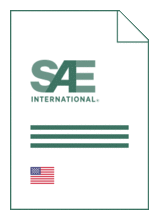
Standard [CURRENT]
SAE J 399:2023-05-22
Anodized Aluminum Automotive Parts
- Publication date
- 2023-05-22
- Original language
- English
- Pages
- 4
- Publication date
- 2023-05-22
- Original language
- English
- Pages
- 4
Product information on this site:
Quick delivery via download or delivery service
Buy securely with a credit card or pay upon receipt of invoice
All transactions are encrypted
Short description
Automotive parts can be fabricated from either coiled sheet, flat sheet or extruded shapes. Alloy selection is governed by finish requirements, forming characteristics, and mechanical properties. Bright anodizing alloys 5657 and 5252 sheet provide a high luster and are preferred for trim which can be formed from an intermediate temper, such as H25. Bright anodizing alloy 5457 is used for parts which require high elongation and a fully annealed ("0") temper. Alloy 6463 is a medium strength bright anodizing extrusion alloy; Alloy X7016 is a high strength bright anodizing extrusion alloy primarily suited for bumper applications. To satisfy anti-glare requirements for certain trim applications, sheet alloy 5205 and extrusion alloy 6063 are capable of providing the desired low-gloss anodized finish. Bright anodizing alloys require control of the chemical composition of the alloy to enhance response to chemical brightening and to result in the formation of anodic coatings that are essentially transparent. Additionally, aluminum producers employ fabricating practices to minimize other metallurgical factors that adversely affect response to bright anodizing procedures. For non-heat-treatable alloys, a highly fragmented grain structure is preferred. Fully annealed, recrystallized grain structures are not optimum for bright anodizing. Where high elongations are required with intermediate tempers, fabricating practices are selected to minimize grain recrystallization. Another factor to be considered for trim application is the type of mill surface finish that is required. When the metal working treatments do not mar the mill produced surface appreciably, the smooth, bright rolled, "automotive trim" surface is desirable since it often eliminates the need for expensive mechanical buffing operations. Where trim fabricating procedures might be expected to damage a bright-rolled surface, duller mill finishes can be used and parts are buffed after forming. Bright rolled mill surfaces occasionally are protected with a removable tape or water soluble film. Selection of anodic coating required to protect aluminum parts is influenced by the required corrosion performance and appearance characteristics. Generally, anodic coatings 0.0003-0.0005 in (0.0076-0.0127 mm) thick are used for exterior trim application. Thinner anodic coatings 0.0001-0.0003 in (0.0025-0.0076 mm) are sufficient for interior trim components. Anodic coatings can be dyed to impart color, painted, or inlaid with vinyl or other plastics for aesthetic and/or functional purposes. The Aluminum Association's "Designation System for Finishes" is a recommended guide to assist in specifying anodic coatings for automotive trim.
Loading recommended items...
Loading recommended items...
Loading recommended items...

